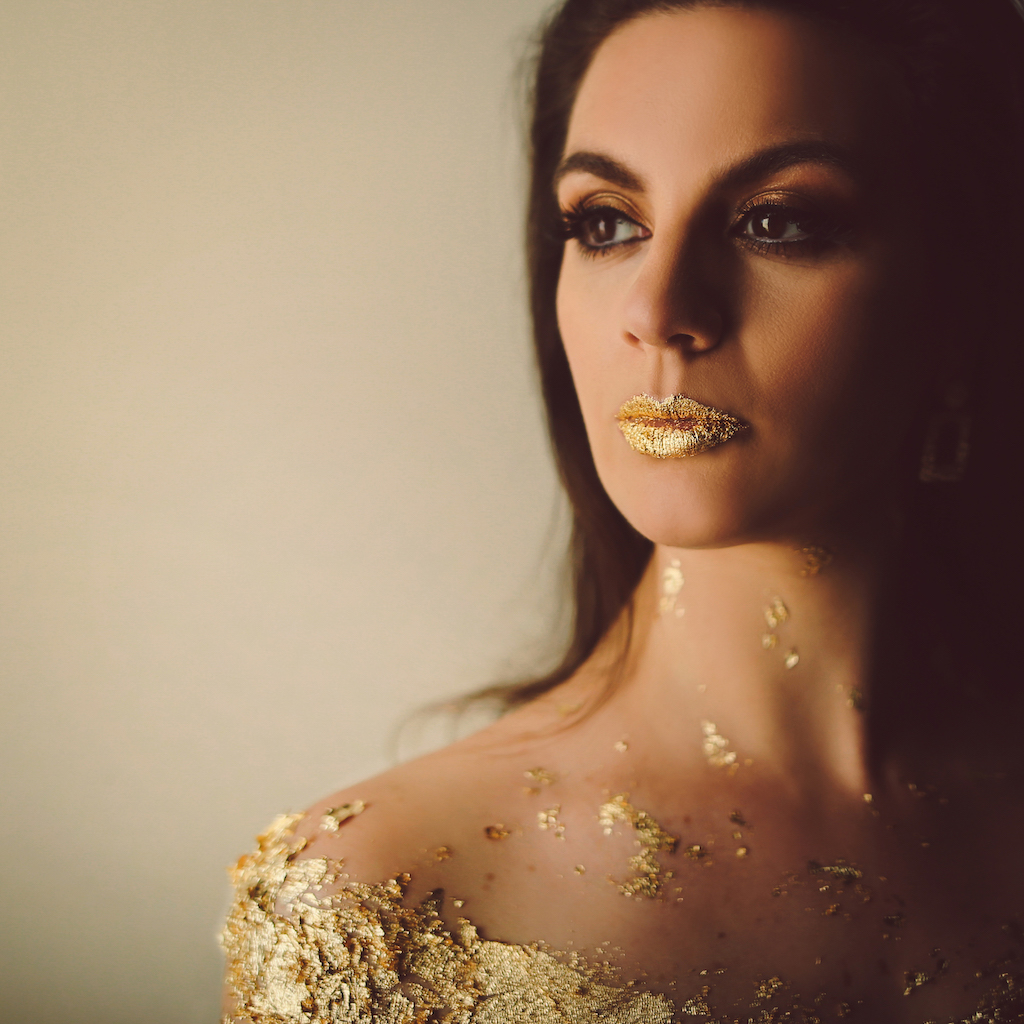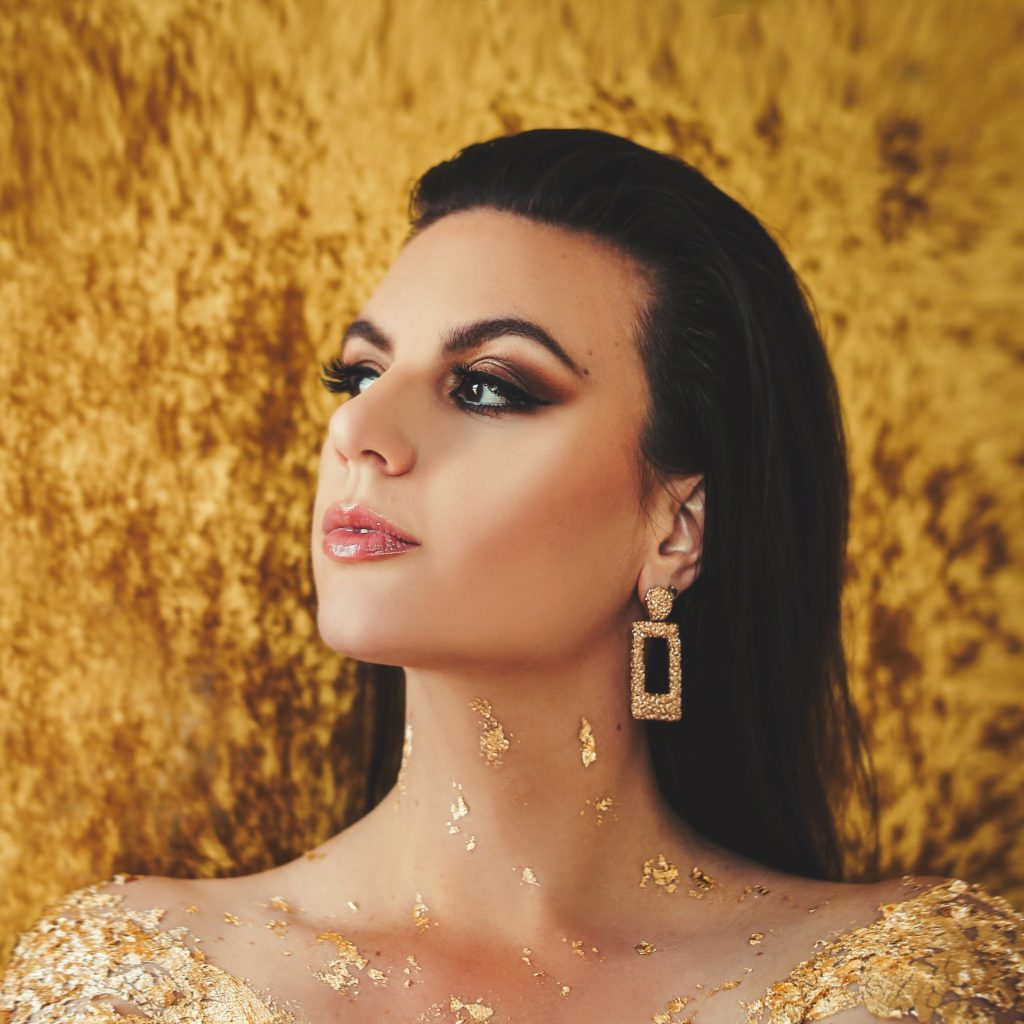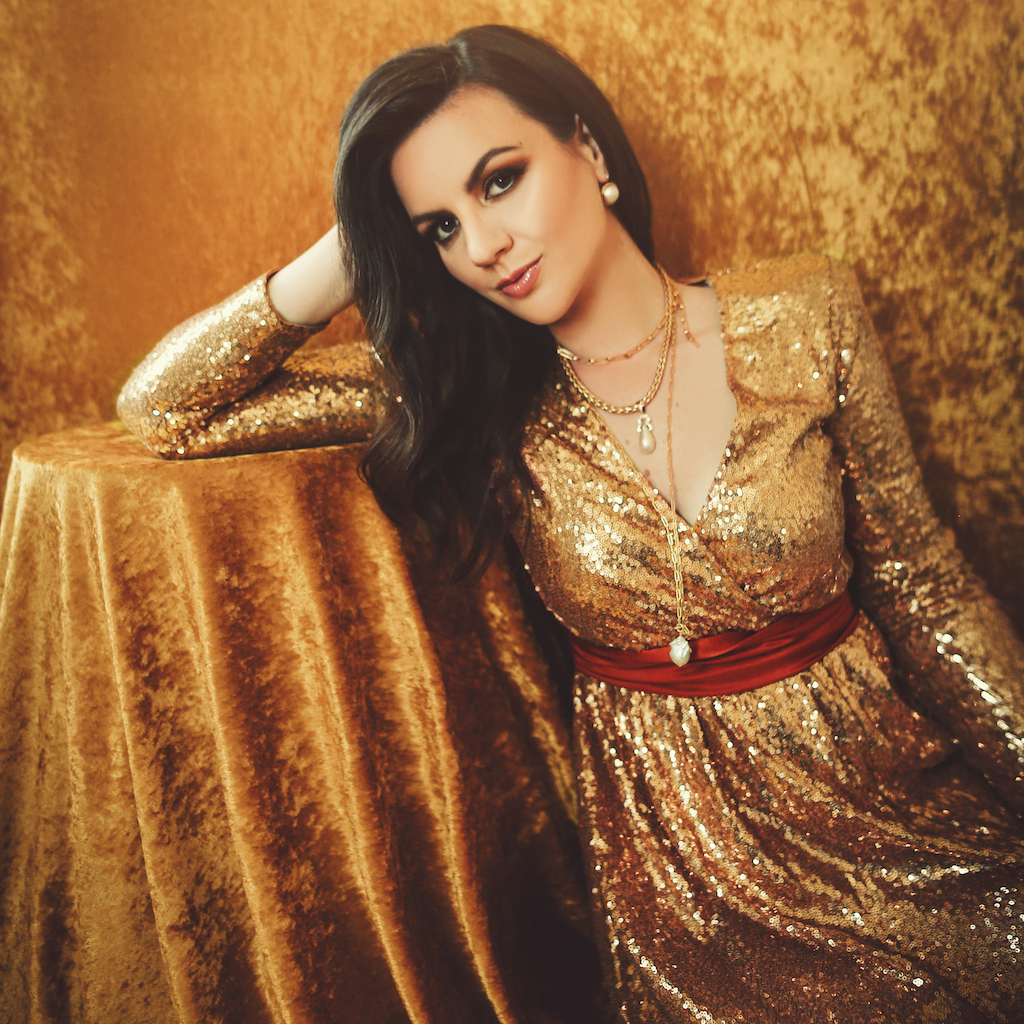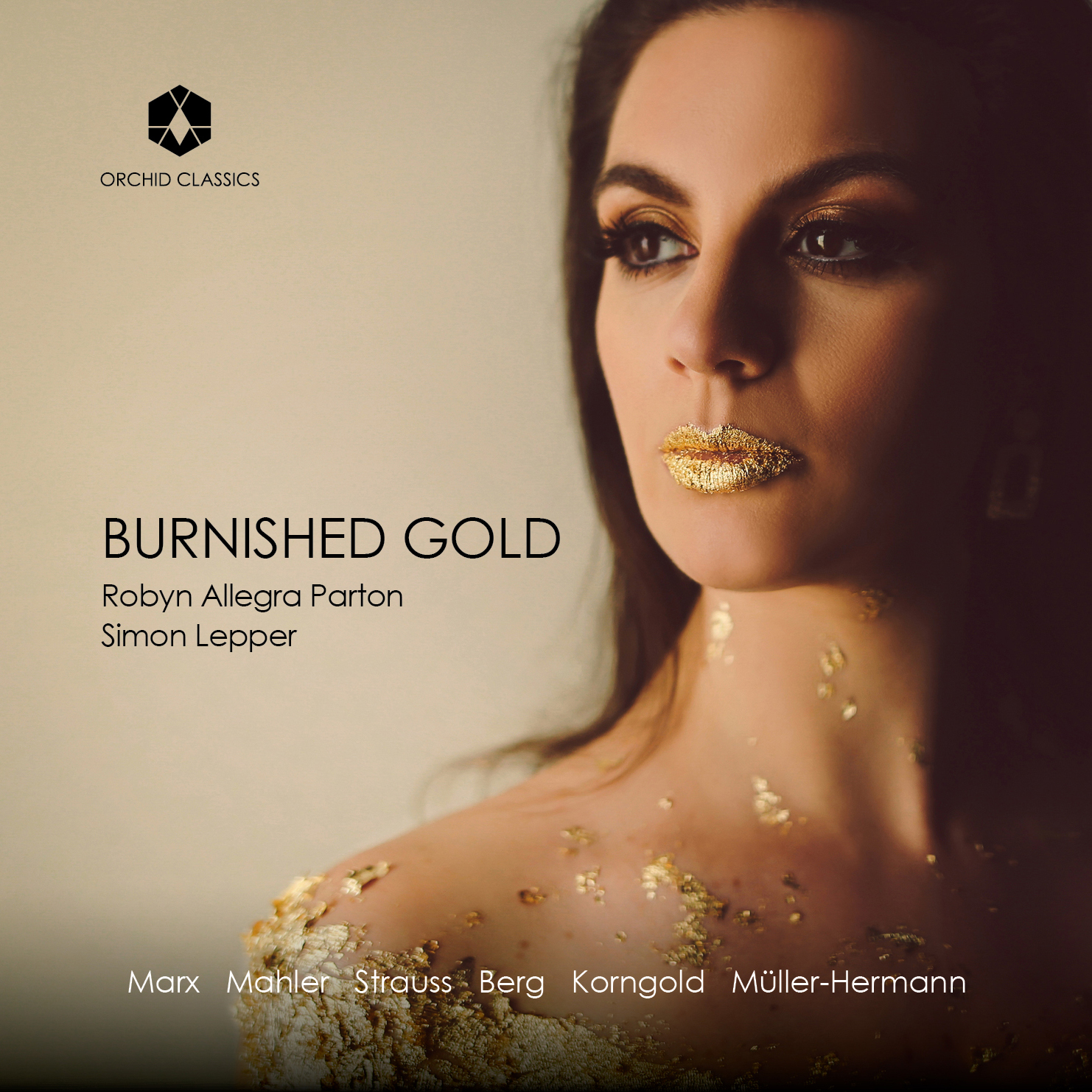Sensuous, brooding and dark-hued atmospheres are blended with rich textures and radiant harmonies in an album inspired by the burnished gold leaf and sensual contours of Klimt’s Art-Nouveau ‘Vienna Secession’ movement.
Including never before recorded songs by Johanna Müller-Hermann.



BURNISHED GOLD
Joseph Marx (1882-1964)
Lieder mit Klavier-Begleitung
1. Nocturne
2. Und gestern hat er mir Rosen gebracht
3. Hat dich die Liebe berührt
4. Windräder
5. Waldseligkeit
Richard Strauss (1864-1949)
6. Das Rosenband, Op.36 No.1
7. Leises Lied, Op.39 No.1
8. Ich schwebe, Op.48 No.2
9. Morgen! Op.27 No.4
Erich Korngold (1897-1957)
Sechs Einfache Lieder, Op.9
10. Schneeglöckchen, No.1
11. Das Ständchen, No.3
12. Liebesbriefchen, No.4
13. Sommer, No.6
Alban Berg (1885-1935)
Sieben Frühe Lieder
14. Nacht
15. Schilflied
16. Die Nachtigall
17. Traumgekrönt
18. Im Zimmer
19. Liebesode
20. Sommertage
Johanna Müller-Hermann (1868-1941)
Zwei Gedichte von Goethe, Op.11
21. Nähe des Geliebten, No.1
22. An die Entfernte, No.2
Alma Mahler (1879-1964)
Vier Lieder
23. Licht in der Nacht
24. Waldseligkeit
25. Ansturm
26. Erntelied
Robyn Allegra Parton, soprano
Simon Lepper, piano
For many, Gustav Klimt’s use of burnished gold-leaf in his paintings is emblematic of 1900s Vienna. The 1897 Art-Nouveau ‘Vienna Secession’ Movement, founded by Klimt and his contemporaries in protest against the traditional Viennese fine art and architectural styles of the age, is perhaps best visually associated with the Secession Building and its ornate, floral gilt-façade. Often taking inspiration from the natural world, the secessionists used asymmetry, long curved lines, and almost sensual ornamentation in their work.
It is easy to draw parallels between these ideals and the highly decorative, impressionist flow of Richard Strauss’ late 1890s Lieder. His musical influence on the remaining composers recorded in the album is clear to the ear. What drew me to design this programme is the tension found in these expansive, programmatic, richly chromatic post-romantic songs on the brink of expressionism, atonality, and the breakdown of formal compositional structure.
Often viewed as a response to the harsh realities of the Industrial Revolution and the Age of Enlightenment’s focus on reason, late-romantic poetry includes common themes of nature and wilderness, man’s inner consciousness, the passage of time, mortality, solitude, wandering, dreaming, and spirituality. In this collection, the words ‘gold’ and ‘rose’ feature regularly, highlighting the importance of embellishment as a means of celebration. With a focus on impressions of feeling or sensation, the artist is often protagonist of his own story. Nature communicates with man through birdsong, scented flowers, starlight, or rustling winds, and there is a sense of existential satisfaction to be found in much of the text.
Women are regularly idealised or treated as supernatural beings in these poems. Just as Klimt wraps women in gold, so do Richard Strauss and Joseph Marx compose for the soprano voice as no Lied composers have before – elevating its flexibility, height, speed and timbre, and pitching it against the warm, full depths of the piano.
Marx’s Nocturne, with its incessant, virtuosic movement in the piano and ever-expanding intervals in the vocal line is, to me, the perfect example of a gilded song. Rolling waves of luscious sound and playful rubato conjure images of the swirling scent of linden-blossom, but never sound superficial. Marx wrote more than 150 songs during his career in Graz and Vienna. While he beautifully upholds the use of diatonic harmony, word painting, and clear structures of form in all of the songs featured here, the extended piano phrases between verses make him somewhat unique in an art-form that rarely shines the spotlight so brightly on the piano alone.
A child prodigy pianist as well as composer, and celebrated in Vienna, the young Erich Korngold was acquainted with Richard Strauss and Gustav Mahler. Aged just 14 when he wrote the first of the Sechs Einfache Lieder, these contrapuntal, intricate, dream-like songs hint at his future style as a film-music composer. Forced to flee annexed Austria in 1938, Korngold moved permanently to the United States of America where he revolutionised film-music composition. Korngold often employed a neo-romantic style of writing and used leitmotifs for characters and concepts in films. Note the three-bar opening phrase of Das Ständchen that repeats later in the song whenever the student singer is mentioned.
Alban Berg was studying with Arnold Schoenberg when he wrote the Sieben Frühe Lieder in 1907, the same year that Klimt completed his ‘Woman in Gold’ portrait of Adele Bloch-Bauer. The influence of Richard Strauss and Richard Wagner can still be heard, however, in the expansive Nacht and Sommertage, and in the ABA-structure and soaring melody of Die Nachtigall. Surprising harmonic twists in Schilflied and Liebesode, and some fast-paced movement through keys in Nacht give only a brief suggestion of experimentation with tonality at this stage, although some songs have already lost their formal strophic shape. Berg’s scores are unusually detailed in dynamics, articulation, and rubato, specifically with differing instructions for the singer and pianist, giving them the appearance of a score as detailed as those of Giacomo Puccini, whose Madama Butterfly had premiered just three years earlier.
Of Johanna Müller-Hermann’s Zwei Gedichte von Goethe, the first song is more playful with regards to tonality. Although firmly centred on F major at the start of the song, it is very quick to pull away, winding through different keys, and side-stepping back to F major barely in time for the end. Like Korngold and Alma Mahler, Müller-Hermann studied with Alexander von Zemlinsky. At the end of World War One, Müller-Hermann took up the position of professor of music theory at the New Vienna Conservatory, the first such post to go to a woman in Austria or Germany.
Of all the songs here, two of Alma Mahler’s Vier Lieder break away perhaps the most from traditional form. While remaining tonal, Licht in der Nacht is sparse and chromatic, and the long coda winds down in tempo and dynamics, triggering a sense that the song itself is drifting into rest along with the poet. Ansturm is unusual in that it employs a recitative style at the beginning of the song, using speech directed at another person. Chords bursting out from the piano match the expressionist statement ‘my desire must come out’/‘mein Begehr… muss es heraus’. With Erntelied we return to almost all of the themes of musical and poetic lyric romanticism, with the folksong-like vocalise at the end bringing nature and man together as one.
Robyn Allegra Parton
“I wanted the album to inspire a sense of nostalgia. A memory of a time of luscious dress and flowing architectural lines, where the edges of artistic creation were embellished with burnished gold.”
Soprano Robyn Allegra Parton and pianist Simon Lepper perform an album inspired by the burnished gold leaf and sensual contours of Klimt’s Art-Nouveau ‘Vienna Secession’ movement, with music reflecting that aesthetic including songs by Richard Strauss, Alma Mahler, Johanna Müller-Hermann, Erich Wolfgang Korngold, Alban Berg and Joseph Marx – a composer about whom Lepper recently curated a series at Wigmore Hall.
These are works that occupy a fascinating realm between the romantic and the modern, so that sensuous, brooding and dark-hued atmospheres are blended with rich textures and radiant harmonies. Described by Opernwelt as ‘captivating, astonishing, overwhelming’, award-winning British soprano Robyn Allegra Parton specialises in this repertoire, and Simon Lepper is one of the finest song accompanists in the world.
Robyn Allegra Parton
Soprano
Described by Opernwelt as ‘captivating, astonishing, overwhelming’, award-winning British soprano Robyn Allegra Parton performs regularly on stages and in concert throughout Europe.
Following studies in musicology, historical performance practice, and composition at the University of Oxford, Robyn began her singing career touring with the Monteverdi Choir under Sir John Eliot Gardiner, and trained in vocal performance at the Royal College of Music in London. Robyn has received prizes from the Oxford Lieder Festival, Innsbruck’s Cesti Competition, Salzburg’s Grandi Voci Competition, France’s Les Azuriales, and Stockholm’s Friends of Folkoperan.
Robyn made her operatic debut as Barbarina (Le Nozze di Figaro) at the Royal Opera House, Covent Garden and has returned there several times, notably as the title role in Mark-Anthony Turnage’s 2018 opera Coraline, to critical acclaim. Further roles in contemporary opera have taken Robyn to Deutsche Oper Berlin, Philharmonie de Paris, Opéra National du Rhin, Folkoperan Stockholm, Istanbul Music Festival, and Glyndebourne Festival Opera. Also drawn to repertoire influenced by the virtuosic Italian belcanto style, Robyn has enjoyed success in Germany and the UK with roles such as Gilda (Rigoletto), Violetta (La Traviata), Lucia (Lucia di Lammermoor), and Zerbinetta (Ariadne auf Naxos).
Robyn has performed as guest soloist with the Leipzig Gewandhaus, Gustav Mahler Chamber Orchestra, Ensemble Intercontemporain, London Philharmonic, Royal Philharmonic, Orchestra of the Age of Enlightenment, English Baroque Soloists, and the Royal Oman Symphony Orchestra. Robyn has recorded Charpentier’s Caecilia Virgo et Martyr for Novum, Three Winter Songs by Stephen Dodgson for Toccata Classics, and the roles Alice and Lucy in Stephen Dodgson’s opera Margaret Catchpole for Naxos.
www.robynallegraparton.com
Simon Lepper
Piano
Simon read music at King’s College, Cambridge before studying collaborative piano with Michael Dussek at the Royal Academy of Music in London and later with Ruben Lifschitz at the Académie de Royaumont, France.
Specialising in song accompaniment, he has regularly collaborated with singers including Benjamin Appl, Ilker Arcayürek, Christiane Karg, Karen Cargill, Stéphane Degout, Angelika Kirchschlager, Sally Matthews and Mark Padmore, He performs extensively in venues around the world including Carnegie Hall, the Concertgebouw, the festivals of Verbier, Ravinia and Edinburgh and the Opera houses of Frankfurt, Geneva, Bordeaux and La Monnaie. In his home country, he is often heard on BBC Radio 3 and regularly performs at the Wigmore Hall where he has also curated a series on the songs of Joseph Marx.
He is a committed teacher and is currently professor of collaborative piano and a vocal repertoire coach at the Royal College of Music, London where he also co-ordinates the collaborative piano course. Since 2003 he has been the official accompanist for the BBC Cardiff Singer of the World Competition.
His discography includes a live recital disc with Stéphane Degout and a disc of Ballades, Mahler songs and a French Song recital with Karen Cargill, 2 volumes of Debussy Songs and a Strauss disc with Gillian Keith, the complete songs of Jonathan Dove with Kitty Whately, Schubert Songs with Ilker Arcayürek and a recital disc with Dame Felicity Palmer.
www.simonlepper.com

Click the button above to download all album assets.

